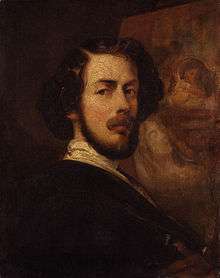Thomas Jones Barker
Thomas Jones Barker (1815 – 27 March 1882) was an English historical and portrait painter.


Biography
Born at Bath, in 1815.[2] He was the son of the painter Thomas Barker and studied in Paris under Horace Vernet, in 1835-45 exhibited much at the Salon and subsequently at the Royal Academy. Probably influenced by Vernet, some of his earliest military paintings were of scenes from the Napoleonic Wars including his 1853 Royal Academy piece "Wellington at Sobrauren".
In his later life he was known especially as a military painter, and observed on the spot the Franco-Prussian War. It is unclear whether he was a first-hand witness of the Crimean War but he did exhibit a number of paintings depicting this war. One of his most famous paintings from the 1850s was "The Relief of Lucknow" completed in 1859. The picture which was shown to Queen Victoria in May 1860, contained numerous portraits based on sketches taken by the Swedish artist Egron Lundgren, who had traveled to India in 1858. Other significant works by Barker include "The Bride of Death" (1840); "The Meeting of Wellington and Blücher" (1851); "Wellington Crossing the Pyrenees (1857);" "The Mêlée - Charge of Cuirassiers and Chasseurs" (1872); "Balaklava - One of the Six Hundred" (1874); "The Return through the Valley of Death" (1876); "Major General Williams and His Staff Leaving Kars 28 Nov. 1855" (1857); and "Riderless War-Horses after the Battle of Sedan" (1873).
Paintings
- Wellington at Sorauren. 'Wellington set out on horseback, etc.' (Valerian Wellesley, 8th Duke of Wellington)
- Wellington and his aide-de-camp, Lord Fitzroy Somerset, crossing the Pyrenees 1813 (National Army Museum)
- Vittoria, 21 June 1813 (Staff College, Camberley)
- An incident in the Napoleonic Wars (National Museum Wales, Cardiff)
- Taking the Russian Guns at Balaclava (Staff College, Camberley)
- Taking the Russian Guns at Balaclava (School of Electrical and Mechanical Engineering, Borden, Hants)
- The Rally, Balaclava (Naval and Military Club, London)
- The Charger of Captain Nolan bearing back his dead master to the British Lines. 'Poor Nolan is dead, etc (National Gallery of Ireland, Dublin)
- Sir Edward Cockburn and George Cockburn at Balaclava (Victoria Art Gallery, Bath)
- Major General Williams and his Staff leaving Kars, 28 Nov 1855 (National Army Museum)
- Interior with British officers (National Museum Wales, Cardiff)
- Relief of Lucknow (National Portrait Gallery, London)
- The Secret of England's Greatness, 1863, National Portrait Gallery. London
- Riderless War-Horses after the Battle of Sedan. 'In the early morning I visited, etc.' (Southampton Art Gallery)
- Riderless War-Horses after the Battle of Sedan. 'In the early morning I visited, etc.' (Maidstone Museum and Art Gallery)
References
- National Portrait Gallery
- UCLA
Further reading
- Harrington, Peter, 'The Defence of Kars: Paintings by William Simpson and Thomas Jones Barker', Journal of the Society for Army Historical Research, Vol. LXIX, No. 277, Spring 1991, pp. 22–28.
- Harrington, Peter. British Artists and War: The Face of Battle in Paintings and Prints, 1700-1914, London, Greenhill, 1993.
- Nilsson, Sten, 'Egron Lundgren, reporter of the Indian Mutiny', Apollo, Vol. XCII, No. 102, August 1970, pp. 138–143.
Sources
- This article incorporates text from a publication now in the public domain: Gilman, D. C.; Peck, H. T.; Colby, F. M., eds. (1905). New International Encyclopedia (1st ed.). New York: Dodd, Mead. Missing or empty
|title=(help)
External links
- 41 paintings by or after Thomas Jones Barker at the Art UK site